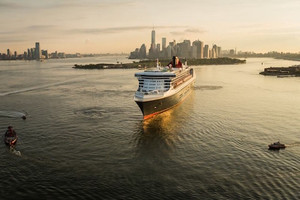
The waterways of Europe have been the lifeblood of some of the world's great cities and civilisations, and deserve more than one day of exploration. Here’s our top pick of river destinations tailor-made for a pre or post river cruise stopover.
Paris
The "City of Light" has exhausted every possible superlative description, and for this reason it remains one of the most loved destinations in the world. Starting or finishing a European river cruise in the French capital can involve visits to major landmarks like the Eiffel Tower, Notre Dame, the Arc de Triomphe, the Champs-Elysées and the Louvre. But Paris is more than just a city with grand icons. Down at street, and river, level is where the magic happens. The avenues and alleys reveal the romance of Paris; you’ll find love-struck couples snatching a refined lunch, elegant ladies walking miniature dogs, and delivery drivers discussing politics over a glass of wine. Each of the 18 districts, has its own personality which makes it the type of place that demands you return.
Lyon
It's a city that converges with the Rhone and Saone Rivers, and 2,000 year old Lyon is anything but a city living in the past. Sure you can see Roman remains and Renaissance architecture, and wander the cobbled streets of the Old Town, a UNESCO World Heritage site, but this is also a place renowned as the gastronomic centre of France. For several centuries, Lyon has been famous for fabulous French cuisine; many of the country's top chefs work in the city, and it’s also served by two world famous wine regions - Beaujolais to the north and Côtes du Rhône to the south. But you don't have to spend a small fortune to enjoy classic French fare. Traditional restaurants called bouchons abound and serve local food and wine at inexpensive prices.
Vienna
The Austrian capital conjures up images of baroque ballrooms, symphony orchestras performing Mozart and Beethoven, and austere museums and imperial palaces. Vienna is all of that, but it's also a modern metropolis with a vibrant modern arts scene and strong café and restaurant culture with a real outdoorsy feel. First time visitors usually marvel at the world-famous Opera House, St Stephan’s Cathedral, the Hofburg Palace and the magnificent Schönbrunn Palace, and forget that half the city is made up of "green space" with parks and gardens scattered everywhere with their own mini-monuments. When the locals aren't eating and drinking at a café or local Austrian pub, they're out walking, cycling or rollerblading in the city's parks and gardens, or strolling around at one of the 100 or more art museums.
Budapest
Straddling the mighty Danube River, this is a city with two distinct personalities but its madness is confined to the sheer fun that Budapest enjoys, especially in the summer months. The Danube literally splits the older "Buda" side of the city from the cosmopolitan "Pest" area, which is home to the National Opera House and the historic Heroes' Square. Architecturally stunning, this is a great city for walking, and the riverside embankment is a good way to get a feel for Budapest. Andrássy Avenue, a UNESCO World Heritage site, is surrounded by spectacular neo-renaissance architecture and is also lined with shopping streets, cafés, restaurants, and theatres. This and the Castle District, with views over the whole city, are the main touristy areas, and the great thing about wandering and taking in all the grand monuments, is that in between is inexpensive food and wine at local restaurants.
Prague
The Czech capital is often compared to Paris, but the cold hard truth is that for all the grandeur of the French capital, it lacks the welcoming charm and sheer beauty of Prague. Very few cities in the world can match its architectural appeal, but there’s more to this ancient city than perfectly preserved medieval and historical buildings. Wandering the city streets, a common scene is impromptu performance on a cobbled corner or in a warm café, or book readings on a medieval bridge. In the past decade or so, it's true that Prague has become a little over run with tourists, who tend to congregate around the main sights at Staré Mêsto - the gothic “Old Town” or the back streets of the Malá Strana, the 13th century “Little Quarter” and Charles Bridge, but there are still intimate pockets of the city begging to be explored.
Amsterdam
It's a city built around a concentric network of canals spanned by more than 1,000 bridges, and is as famous for its museums and architecture as it is for its open-minded and creative attitude. Its liberal people tolerate soft drugs and prostitution, but far from being a "city of sin", Amsterdam rewards visitors with an open-ness about its fascinating culture which makes it one of the most progressive of European cities. There is a Red Light district and you can buy joints in coffee shops, but that all seems somewhat trivial in comparison to the 55 museums, 60 art galleries, 20 theatres and 12 concert halls which are scattered among the canals of Amsterdam. Once you've visited the Rijksmuseum, the Van Gogh Museum, Anne Frank House, and the Royal Palace then it's time for a reward of a bit of bar hopping along the canal cafés that are the heart and soul of Amsterdam's culture.
Moscow & St Petersburg
Russia's two most important cities are often featured on sailings that combine the Volga River, Moscow Canal and other waterways. Combining them goes some way towards understanding one of Europe's great empires, which can be gained by standing in the immense Red Square in Moscow, with the colourful domes of St. Basil's Cathedral as a backdrop. Then there's the Kremlin, former home to the Russian Czars and now the official residence of the country's president. And in St Petersburg, Russia's cultural capital, the State Hermitage Museum in the Winter Palace has to be seen to be believed with more than three million pieces on show representing every era in the country's history. The city itself is a living museum, and the ultimate way to cap off a visit is to catch a live Russian ballet.
Cologne
The Rhine River winds past Cologne, and the soaring twin steeples of its Gothic cathedral stands sentinel over the 2,000 year old German city. The World Heritage-listed cathedral is simply called "The Dom" and is the symbol of Cologne and one of Germany's most famous architectural monuments, and this is pretty much the starting point for any visit to the city. Wandering the streets reveals a bizarre mix of medieval architecture, pretty art galleries, museums and bland post-war buildings. Of these the four medieval city gates (there were originally 12) from Roman occupation stand as the most interesting snapshot of the city, along with the 12 Romanesque churches scattered around Cologne. Down on the river front is a slew of restaurants, bars and cafés while the beer halls are lively places that rival those in Bavaria.
Basel
Located right on the border of Switzerland, Germany and France, Basel is a real multicultural city with the Rhine River at its heart. The Old Town of Basel is perhaps the most significant heritage site in this area, but there's also Basel Münster, which is a gothic-romanesque church with red sandstone architecture and coloured roof files and Basel's elegant Town Hall. In typical Swiss fashion, ancient buildings seem to blend in comfortably among the modern with world renowned architects creating an aesthetically pleasing cityscape. Sightseeing aside, this is a city with a distinctive cultural edge, and its museums cover a broad range of collections with a concentration featuring the fine arts. It's referred to as the Culture Capital of Switzerland but in summer, the city seems to let its hair down a little as locals plunge into the Rhine to celebrate the hot weather and spill out from bars onto the streets.
- By:
- Joanna Hall
Reviews
-
Oldies
I love the idea of visiting all these places but friends tell me that their parents go on these cruises (and I'm in my 40s!) Not being ageist but we prefer a younger crowd. Do any of these cruise lines cater to people like us?










